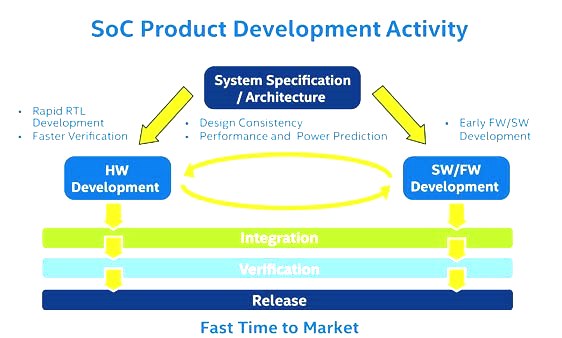With the ever-increasing complexity of the platforms, intellectual property block (IP) integration from multiple suppliers, and complex validation and testing, architects can no longer rely on past experience, excel spreadsheets, and worst-case scenario static calculations to address system-on-chip design challenges. In addition, time-to-market requirements have to be met while keeping performance improvements, power consumption, and cost within budget guidelines. To address those challenges and constraints, “Shift Left” principles can be applied to reduce the time between concept and bring-up. As illustrated below in the traditional design cycle, the software/firmware development iterations arrive too late in the process.

This can be improved by co-designing and co-developing hardware and software together with use of modeling and simulation capabilities.

The use of executable specifications and virtual prototypes enable hardware and software development in parallel. It also enables identifying hardware and software design constraints prior to development as well as predicting and optimizing system behavior and performance.
Instead of a waterfall
For SoC design, product development can be made collaborative across software and hardware teams thanks to the parallel nature of the design flow. Instead of a waterfall of specifications and reinterpretations that leave resulting systems susceptible to functional and performance bugs (a major resources and time sink), modeling technologies can be used to create a consistent design flow from the specification phase down to micro-architecture and logic design phase.

Eclipse provides a meta-modeling framework that can help in implementing that kind of parallel flow, effectively addressing all the main areas of product development: software (driver and firmware) development, architectural exploration, micro-architecture design, verification and RTL design.
More benefits
In addition, during the product development lifecycle, maintaining consistency across models and documentation is crucial for reducing the potential for bugs in software-hardware integration. The traditional manual approach of creating models and specification documents separately is error prone, especially since many different teams can refine these collaterals in different environments and there are usually no automated consistency checking mechanisms. The use of meta-model based design flows can close the consistency gap between all system’s representations.
Meta-model based design flows offer capabilities for system-level design exploration including both hardware and software/firmware. They enable:
- Virtual architecture exploration and analysis of complete systems
- Early performance projections to avoid costly re-design
- Rapid “what-if” analysis of different scenario thanks to the reduced and parallelized design flow
- Consistent and smooth design flow through the use of bridges between each design phase
- Faster time-to-market
A great example of a tool that offers capabilities as described above is Intel CoFluent Technology. It has been successfully applied to the design of end-to-end IoT solutions as well as the optimization of big data systems. CoFluent Studio v6.0 is the latest release of this technology. You can find more information at thel CoFluent Technology Website http://goo.gl/gHZOhN.
Advertisement
Learn more about Intel





